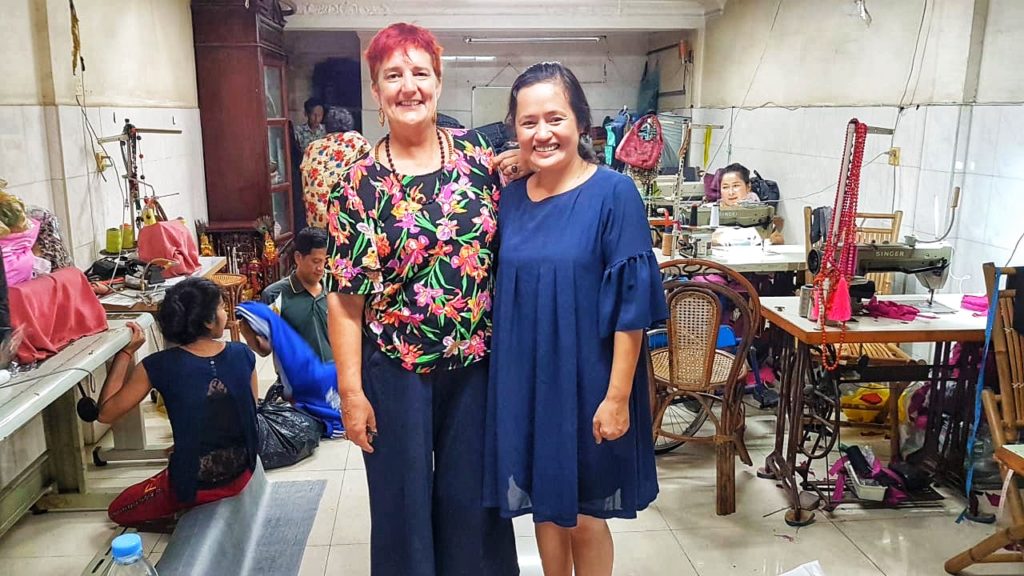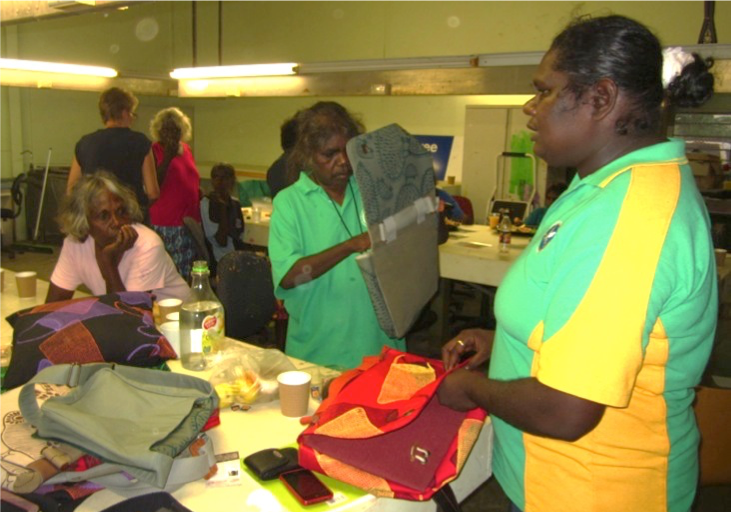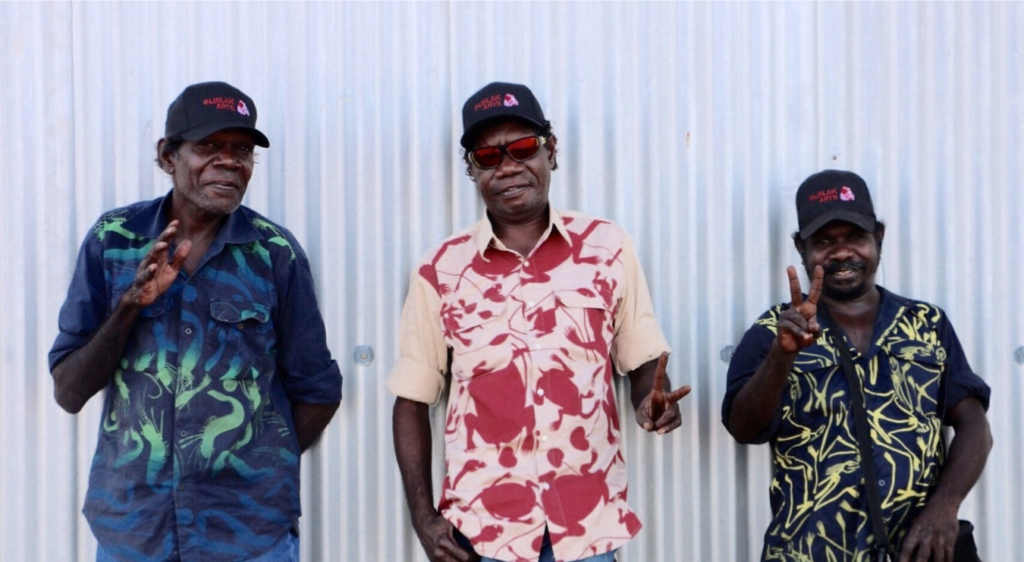FAQs
Why did you set up Flying Fox Fabrics?
In a nutshell – to find ways of value adding to Indigenous Australian hand printed fabrics. People like to support artists but most want to buy something that’s ready to display or use for themselves, or as a gift. The market for fabric lengths is limited – mostly it’s people who know how to sew. At Injalak Arts, where I was Mentor Manager for six years, we had an 8 metre fabric printing table. The printers really like coming to work and printing, and the artists loved creating designs and then seeing them printed (plus getting the royalties) – but we had to find creative ways to sell it. No sales means no more printing. People would visit the art centre, look at the freshly printed fabric and say – ‘what do you do with it? tablecloths?’ I was thinking and thinking – what can we do with this fabric? Once I started the project at Injalak Arts it quickly became really important to the printers, the artists, the community and the artisans who made the products. It was good for local people economically, socially and culturally. The locals loved the bags and clothing, and so did the customers. So when it was not going to be continued by Injalak Arts a lot of people were going to be impacted if it didn’t continue.

How did you get the idea?
Working for and with Australian Indigenous art centres for 30+ years is the foundation upon which Flying Fox Fabrics is built – an unparalleled track record of promoting authentic and ethical art and craft businesses. Plus I spent two years in Cambodia working as a volunteer Management Adviser to a local NGO under the AVI program from 2010. I continue to be involved with the country and developed strong networks with the fair trade social enterprises that employ disabled and disadvantaged artisans. My home in Riverside was only two blocks from Kravan House and I visited the shop regularly to buy gifts and befriended the owner/founder Hok Thanan. One day in 2012 I asked Thanan whether she would be prepared to make products from other people’s fabrics. Her response was classic Cambodian “why not?“.

In late 2012 I was asked to undertake consultancy work as Change Manager and Business Planner for Injalak Arts. Still based in Cambodia throughout 2013, on one of my trips back to spend time with my partner and nephew who still lived there, I took small amounts of hand-printed fabric from Injalak Arts in my luggage. I paid the producers and all costs with my credit card, not sure if the idea had legs. When the first lot of bags came back to Australia they met with enthusiasm, the project was immediately successful.
In 2014/15 I undertook an Ausindustry funded consultancy and called it Flying Fox Network. The goal was undertake Supply Chain Analysis in fabric printing working with Bula’bula Arts, Wadeye and Injalak Arts. For this project I took fabric from all three art centres to Cambodia and distributed it to manufacturing partners. The stock looked fantastic and when taken back to each of the art centres were adored. The exercise demonstrated that diverse designs worked on accessories.

Although there was scope for expanding the project then, I chose to focus on working with Injalak Arts and when I became an employee in late 2015 continued to facilitate it just for Injalak Arts. Over six years the project grew and contributed significantly to livelihoods in Australia and Cambodia.

Flick and Flying Fox Fabrics are no longer formerly affiliated with Injalak Arts after a change of management in February 2019 and the new management declined to continue the project. From a challenge came an opportunity and Flying Fox Fabrics was established as a new entity and diversified to source fabrics from Indigenous Australia, Cambodia and Africa.
Why Cambodia?
There are many disabled and disadvantaged people and with no social security there is no form of government support.
Cambodia has a history of exquisite textiles in the form of silk production and ikat weaving. Many artisans perished during the Khmer Rouge years and craft traditions were completely disrupted and some were almost lost. After years of disruption and war from 1970 – 1994 Cambodia finally began to experience a period of peace and relative stability so allowing people to regroup and small businesses to begin tentatively operating. Sadly many people had and continue to suffer injuries and physical disabilities as a result of war, disease, landmines and poor access to medical treatment.
After the cessation of conflict in the early 1990s it was possible for normal life to begin again and earning money through enterprise was seen as a way out of poverty. Social entrepreneurs such as Thanan Hok established their own businesses, she was the first in 1993. A number of international non-government-organisations (NGOs) and volunteers gave support to recovering craft traditions in danger of being lost and also the development of new skills and products that could create livelihoods for people suffering from disadvantage. They did this by setting up workshops and cooperatives such as Villageworks and Watthan. These were both later handed over to local people.
Where does the money go?
Flying Fox Fabrics pays a fair price for the fabric our products are made from and to the social enterprises that make them. We do not look for the cheapest production partner we look for quality + ethics, we do not try to bargain on price (believe it or not, some people do!). In Cambodia our production partners either exclusively employ or target disabled people for employment. We share and will be sharing the stories of individual artisan makers so you can see how their lives are transformed by right livelihoods.
Australian fabrics are sourced from remote community art centres. It is not cheap to print or buy art centre fabric, however, we know that the designers and printers are being paid fairly and that buying from art centres supports local livelihoods and cultural maintenance and creates real social impacts.
For any Flying Fox Fabric product 60-75% of the wholesale price is shared between the art centres and the manufacturers.
Why get the products made in Cambodia (and not Australia)?
Discrimination and lack of opportunities are the two key challenges for disabled people in Cambodia. There is no social security, there are no pensions, no Government benefits and the health system is bad. (Could say a lot more about the state of the ‘health’ system in Cambodia but best to be discreet.) The social enterprises we work with are making a really important contribution to wellbeing in Cambodia. Another good reason is that production costs are lower than Australia due to differences in cost of living – it’s cheaper to live in Cambodia. Therefore our products are not only hand-made and high quality – they affordable and they create positive social and economic impacts in two countries.
Why does Cambodia need assistance?
The Kingdom of Cambodia is an extraordinary land full of contrasts including great beauty and also great suffering. For 20 years, from 1970 – 1990, the country experienced some of the most disruptive events imaginable including the war in neighbouring Vietnam and mass bombing in the countryside by the US forces, the genocidal Khmer Rouge (‘Pol Pot’) regime (1975-79) followed by more than 10 years of civil war and disruption. During this time millions of people died or went missing. Every family was impacted. Slowly peace returned in the 1990s, however, Cambodia is still a recipient of foreign aid and employment opportunities are very limited. Yet the skill level of artisans is extremely high. Our founder was a volunteer in Cambodia for two years from 2010 – 2012 and continues to have strong networks around the country.
Cambodian garment industry – Cambodia’s greatest industry and net export earner is garment/footwear construction employing staff, usually women, in very large factories often referred to as ‘sweatshops’. Conditions are often grueling. This is why we actively support fair trade workshops.
“Cambodia’s garment sector is the backbone of the country’s export-driven economy and employs 86 percent of all factory workers…. About 40 percent of Cambodia’s GDP comes from garment exports, while more than 800,000 people are employed in garment factories around the country… The minimum wage has risen from $61 in 2012 to $170 this year (2019)… The EU imports more than 40 percent of Cambodia’s garments.” Source: The Phnom Penh Post 6.8.2019
What is fair trade?
“Trade between companies in developed countries and producers in developing countries in which fair prices are paid to the producers.”
Flying Fox purchases fabrics from the producers for the price they set and pays the manufacturers the price they request. Although art centres are in a ‘developed’ country, they have very big challenges with their designs being ‘ripped off’ and reproduced without authorisation.
Adopting fair trade principles inevitably makes fair trade products more expensive than unfairly traded products where producers are exploited/underpaid. Cambodia does not have a fair trade accreditation scheme, however, we choose our partners carefully. We visit their workshops and speak with the artisans. It is a small sector. Each of our partners is known to us personally and we can assure our customers that they are ethical businesses that abide by fair-trade practices. For trade to be fair there needs to be access to ethical products and ethical consumers willing to act to support fair trade.
WFTO prescribes 10 Principles that Fair Trade Organisations must follow in their day-to-day work:
Principle One: Creating Opportunities for Economically Disadvantaged Producers
Principle Two: Transparency and Accountability
Principle Three: Fair Trading Practices
Principle Four: Payment of a Fair Price
Principle Five: Ensuring no Child Labor and Forced Labor
Principle Six: Commitment to Non Discrimination, Gender Equity and Freedom of Association
Principle Seven: Ensuring Good Working Conditions
Principle Eight: Providing Capacity Building
Principle Nine: Promoting Fair Trade
Principle Ten: Respect for the Environment
Essentially fair trade is taking care of people. If you want to get products cheap, it comes at a cost and that is usually paid by the people who produce/make them.
